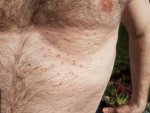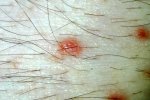Hip
Senior Member
- Messages
- 18,109
I've had a group of mysterious red spots just under my chest on my left side for at least 10 years I think, probably as long as I have had ME/CFS.
These spots are ever-present: they never go away, and over time they barely change (the exact same cluster of spots in the same positions is maintained for years). But they are only at one place, just under my left chest. They are not itchy (although very occasionally there might be a very mild itch in the spot area).
I believe these sort of red spots are called petechiae. I attach 4 pictures of these spots below.
I am wondering whether these red spots might be indicative of some condition, perhaps an infection of some sort. But note these spots have not cleared up or improved after various courses of antibiotics taken for a few weeks.
Anyone have any ideas what they might be?
One Lyme website (not an authoritative medical site) had a picture of similar red spots, and said these were caused by Babesia infection (Babesia is a malaria-like parasite), which I have not been tested for (and I understand it is hard to test for).
EDIT: @sometexan84 mentioned guttate psoriasis, and looking at pictures of guttate psoriasis, that could well be what I have (especially because I previously had regular psoriasis).
Psoriasis of course is an autoimmune skin condition. I may have even found a treatment for my psoriasis — see this post.
Red Spots Just Below My Chest

See the other pictures of these red spots below:
These spots are ever-present: they never go away, and over time they barely change (the exact same cluster of spots in the same positions is maintained for years). But they are only at one place, just under my left chest. They are not itchy (although very occasionally there might be a very mild itch in the spot area).
I believe these sort of red spots are called petechiae. I attach 4 pictures of these spots below.
I am wondering whether these red spots might be indicative of some condition, perhaps an infection of some sort. But note these spots have not cleared up or improved after various courses of antibiotics taken for a few weeks.
Anyone have any ideas what they might be?
One Lyme website (not an authoritative medical site) had a picture of similar red spots, and said these were caused by Babesia infection (Babesia is a malaria-like parasite), which I have not been tested for (and I understand it is hard to test for).
EDIT: @sometexan84 mentioned guttate psoriasis, and looking at pictures of guttate psoriasis, that could well be what I have (especially because I previously had regular psoriasis).
Psoriasis of course is an autoimmune skin condition. I may have even found a treatment for my psoriasis — see this post.
Red Spots Just Below My Chest
See the other pictures of these red spots below:
Attachments
Last edited:




